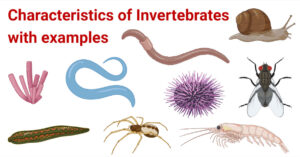Back to: ZOOLOGY 200 Level
It’s always great to see your commitment to learning. Today, we’re stepping into a fascinating part of Zoology—Key Diagnostic Features of Invertebrates. You’ll learn how to identify different types of invertebrates by their unique features. By the end of this lesson, you’ll be able to look at an animal without a backbone and confidently say, “I know exactly what group you belong to.” Let’s get started!
Key diagnostic features of invertebrates
Understanding Invertebrates
Invertebrates are animals without backbones. They form the majority of animals on Earth. From the buzzing mosquito to the colourful coral under the sea, invertebrates are everywhere. Though they may seem simple, they are incredibly diverse and have very interesting structures and behaviours.

To make them easier to study, invertebrates are grouped into phyla—each with unique features used to identify them. These features are called diagnostic features and they help us know which animal belongs to which group.
Phylum Porifera (Sponges)
Sponges are the simplest animals. They are mostly found in water, especially in oceans. They don’t have organs or true tissues. Instead, their bodies are full of pores which allow water to flow through them. This is how they feed and breathe. A common diagnostic feature is their porous body and their skeleton made of spicules.
Phylum Cnidaria (Jellyfish, Corals, Sea Anemones)
These animals have soft bodies with a single opening that serves as both mouth and anus. They possess specialised stinging cells called cnidocytes, used for protection and capturing food. Most of them have radial symmetry, meaning their body parts are arranged around a central axis.
Phylum Platyhelminthes (Flatworms)
Flatworms have flat, soft bodies. They are usually found in moist environments. Most are parasites, like tapeworms, which live inside other animals. They have no body cavity and only one body opening. Their diagnostic feature is their flat, unsegmented body and simple organ systems.
Phylum Nematoda (Roundworms)
These worms are long and round in shape, with a smooth body. They have a complete digestive system with two openings—mouth and anus. Many are also parasitic, such as Ascaris. Their key feature is the cylindrical, unsegmented body.
Phylum Annelida (Segmented Worms)
These include earthworms and leeches. Their bodies are divided into segments, which make movement more efficient. Each segment often contains repeating organs. Annelids have a true body cavity and a closed circulatory system. Their diagnostic feature is their segmented body structure.
Phylum Arthropoda (Insects, Crustaceans, Arachnids)
This is the largest group of animals on Earth. They have segmented bodies, jointed legs, and a hard exoskeleton made of chitin. Insects like grasshoppers, crabs, spiders, and millipedes all belong here. Diagnostic features include jointed limbs and an exoskeleton.
Phylum Mollusca (Snails, Octopuses, Clams)
These animals have soft, unsegmented bodies. Many have a hard external shell made of calcium carbonate. They have a muscular foot for movement and a specialised feeding structure called a radula. Their key feature is their soft body, often protected by a shell.

Phylum Echinodermata (Starfish, Sea Urchins)
These marine animals have spiny skin and a unique water vascular system used for movement. They show radial symmetry as adults, and have tube feet that help them stick to surfaces. Their diagnostic feature is their spiny body and tube feet.
Summary
Invertebrates are animals without backbones, and they’re grouped based on diagnostic features like body symmetry, presence of segments, limbs, and specialised organs. Key phyla include Porifera, Cnidaria, Platyhelminthes, Nematoda, Annelida, Arthropoda, Mollusca, and Echinodermata—each with unique characteristics that make identification easy.
Evaluation
- What are invertebrates, and why are diagnostic features important?
- Identify two unique features of Arthropods.
- How can you distinguish between Annelids and Nematodes?
- Give two examples of animals in the Mollusca and Cnidaria phyla.
Each step you take in learning builds your strength as a Zoologist. You’re not just reading; you’re growing your understanding of the living world. Afrilearn is here to keep supporting you every step of the way. Let’s keep the energy going as we move to the next exciting topic!
